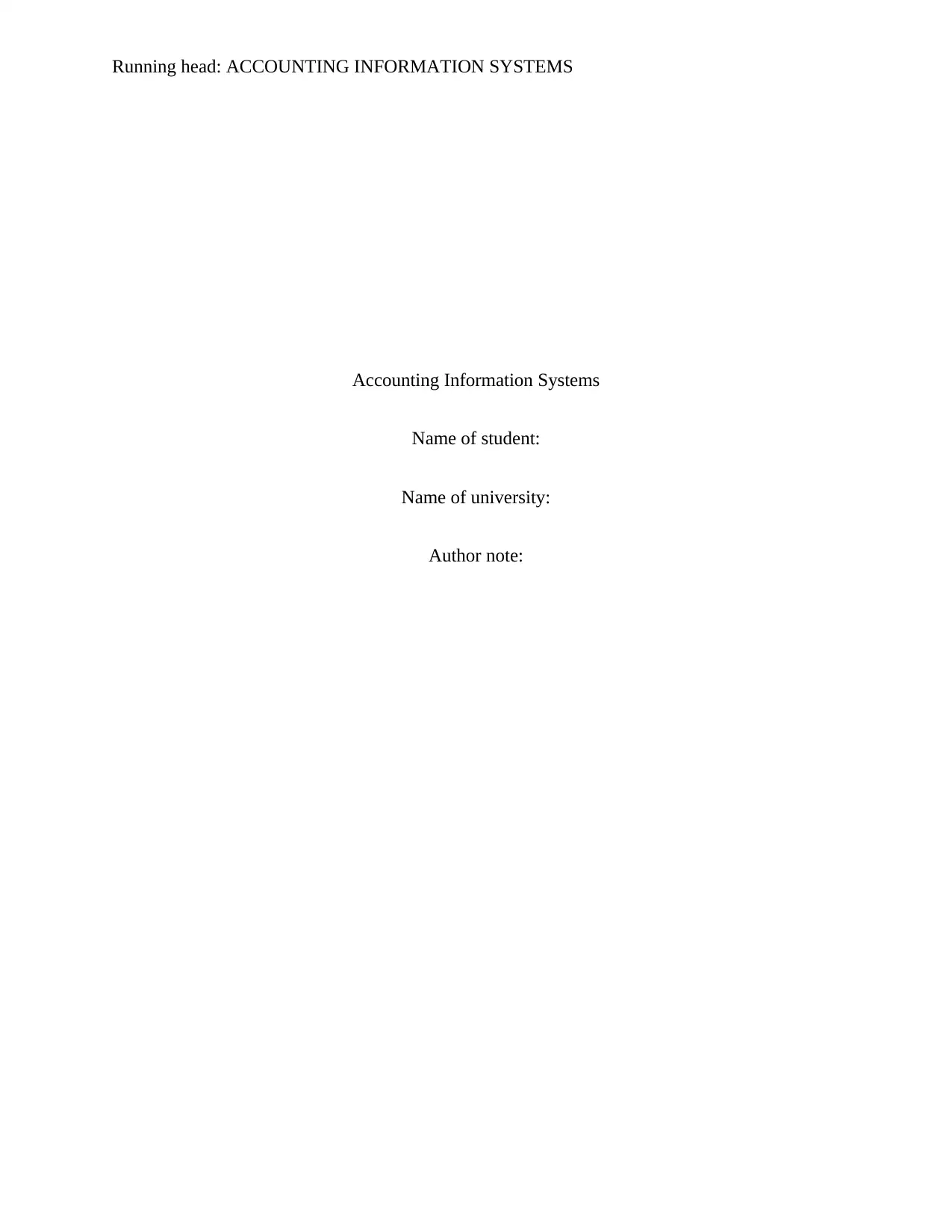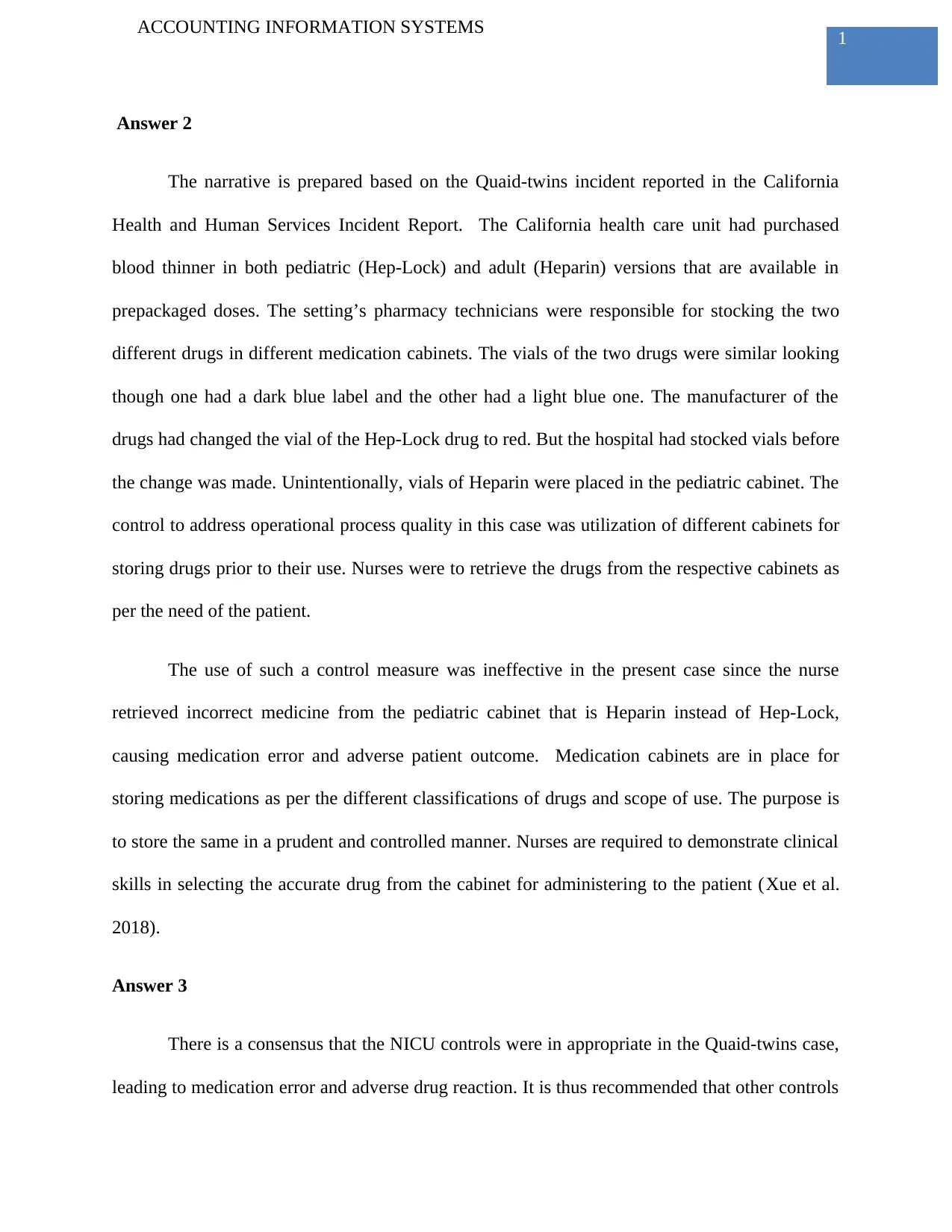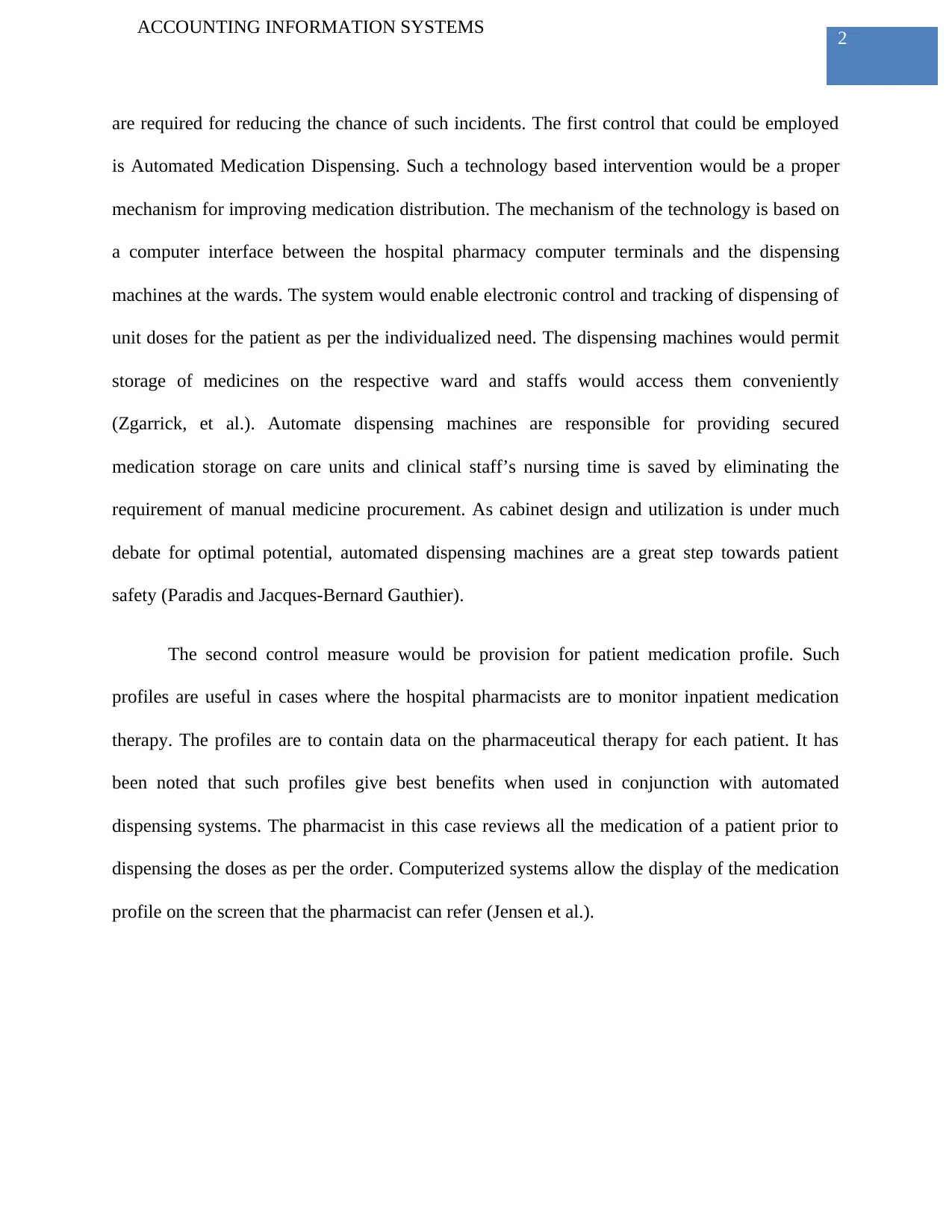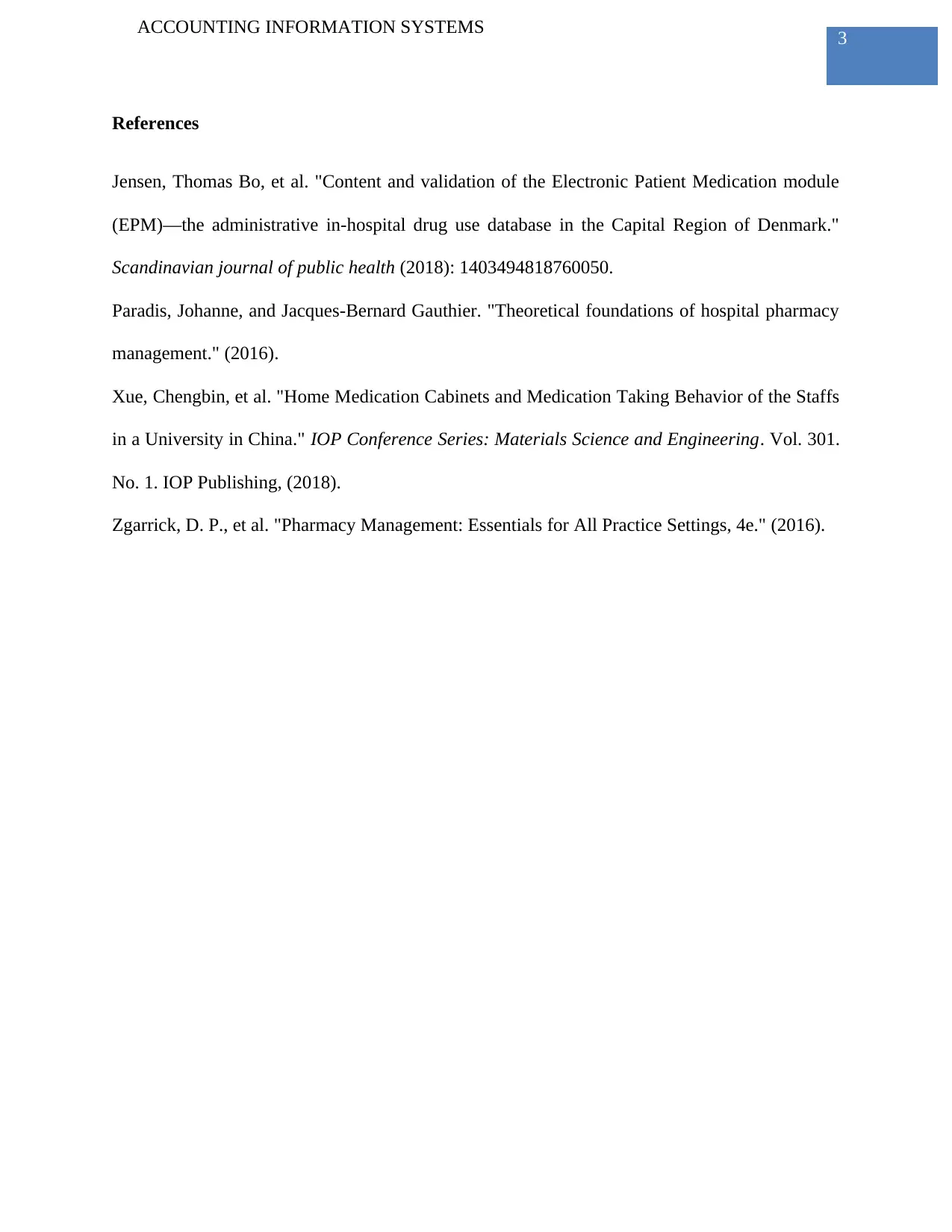Case Study: Evaluating Controls in a NICU Medication Error Incident
VerifiedAdded on 2023/06/11
|4
|760
|329
Case Study
AI Summary
This case study examines a medication error involving the Quaid twins in a NICU, stemming from confusion between pediatric and adult blood thinner medications. The existing control, relying on separate medication cabinets, proved ineffective. The analysis suggests implementing automated medication dispensing systems and patient medication profiles to enhance safety and reduce errors. Automated dispensing machines offer secure storage and reduce manual procurement time, while patient medication profiles allow pharmacists to monitor medication therapy comprehensively, further improving patient safety and medication management. Desklib provides access to similar case studies and solved assignments for students.

Running head: ACCOUNTING INFORMATION SYSTEMS
Accounting Information Systems
Name of student:
Name of university:
Author note:
Accounting Information Systems
Name of student:
Name of university:
Author note:
Paraphrase This Document
Need a fresh take? Get an instant paraphrase of this document with our AI Paraphraser

1
ACCOUNTING INFORMATION SYSTEMS
Answer 2
The narrative is prepared based on the Quaid-twins incident reported in the California
Health and Human Services Incident Report. The California health care unit had purchased
blood thinner in both pediatric (Hep-Lock) and adult (Heparin) versions that are available in
prepackaged doses. The setting’s pharmacy technicians were responsible for stocking the two
different drugs in different medication cabinets. The vials of the two drugs were similar looking
though one had a dark blue label and the other had a light blue one. The manufacturer of the
drugs had changed the vial of the Hep-Lock drug to red. But the hospital had stocked vials before
the change was made. Unintentionally, vials of Heparin were placed in the pediatric cabinet. The
control to address operational process quality in this case was utilization of different cabinets for
storing drugs prior to their use. Nurses were to retrieve the drugs from the respective cabinets as
per the need of the patient.
The use of such a control measure was ineffective in the present case since the nurse
retrieved incorrect medicine from the pediatric cabinet that is Heparin instead of Hep-Lock,
causing medication error and adverse patient outcome. Medication cabinets are in place for
storing medications as per the different classifications of drugs and scope of use. The purpose is
to store the same in a prudent and controlled manner. Nurses are required to demonstrate clinical
skills in selecting the accurate drug from the cabinet for administering to the patient (Xue et al.
2018).
Answer 3
There is a consensus that the NICU controls were in appropriate in the Quaid-twins case,
leading to medication error and adverse drug reaction. It is thus recommended that other controls
ACCOUNTING INFORMATION SYSTEMS
Answer 2
The narrative is prepared based on the Quaid-twins incident reported in the California
Health and Human Services Incident Report. The California health care unit had purchased
blood thinner in both pediatric (Hep-Lock) and adult (Heparin) versions that are available in
prepackaged doses. The setting’s pharmacy technicians were responsible for stocking the two
different drugs in different medication cabinets. The vials of the two drugs were similar looking
though one had a dark blue label and the other had a light blue one. The manufacturer of the
drugs had changed the vial of the Hep-Lock drug to red. But the hospital had stocked vials before
the change was made. Unintentionally, vials of Heparin were placed in the pediatric cabinet. The
control to address operational process quality in this case was utilization of different cabinets for
storing drugs prior to their use. Nurses were to retrieve the drugs from the respective cabinets as
per the need of the patient.
The use of such a control measure was ineffective in the present case since the nurse
retrieved incorrect medicine from the pediatric cabinet that is Heparin instead of Hep-Lock,
causing medication error and adverse patient outcome. Medication cabinets are in place for
storing medications as per the different classifications of drugs and scope of use. The purpose is
to store the same in a prudent and controlled manner. Nurses are required to demonstrate clinical
skills in selecting the accurate drug from the cabinet for administering to the patient (Xue et al.
2018).
Answer 3
There is a consensus that the NICU controls were in appropriate in the Quaid-twins case,
leading to medication error and adverse drug reaction. It is thus recommended that other controls

2
ACCOUNTING INFORMATION SYSTEMS
are required for reducing the chance of such incidents. The first control that could be employed
is Automated Medication Dispensing. Such a technology based intervention would be a proper
mechanism for improving medication distribution. The mechanism of the technology is based on
a computer interface between the hospital pharmacy computer terminals and the dispensing
machines at the wards. The system would enable electronic control and tracking of dispensing of
unit doses for the patient as per the individualized need. The dispensing machines would permit
storage of medicines on the respective ward and staffs would access them conveniently
(Zgarrick, et al.). Automate dispensing machines are responsible for providing secured
medication storage on care units and clinical staff’s nursing time is saved by eliminating the
requirement of manual medicine procurement. As cabinet design and utilization is under much
debate for optimal potential, automated dispensing machines are a great step towards patient
safety (Paradis and Jacques-Bernard Gauthier).
The second control measure would be provision for patient medication profile. Such
profiles are useful in cases where the hospital pharmacists are to monitor inpatient medication
therapy. The profiles are to contain data on the pharmaceutical therapy for each patient. It has
been noted that such profiles give best benefits when used in conjunction with automated
dispensing systems. The pharmacist in this case reviews all the medication of a patient prior to
dispensing the doses as per the order. Computerized systems allow the display of the medication
profile on the screen that the pharmacist can refer (Jensen et al.).
ACCOUNTING INFORMATION SYSTEMS
are required for reducing the chance of such incidents. The first control that could be employed
is Automated Medication Dispensing. Such a technology based intervention would be a proper
mechanism for improving medication distribution. The mechanism of the technology is based on
a computer interface between the hospital pharmacy computer terminals and the dispensing
machines at the wards. The system would enable electronic control and tracking of dispensing of
unit doses for the patient as per the individualized need. The dispensing machines would permit
storage of medicines on the respective ward and staffs would access them conveniently
(Zgarrick, et al.). Automate dispensing machines are responsible for providing secured
medication storage on care units and clinical staff’s nursing time is saved by eliminating the
requirement of manual medicine procurement. As cabinet design and utilization is under much
debate for optimal potential, automated dispensing machines are a great step towards patient
safety (Paradis and Jacques-Bernard Gauthier).
The second control measure would be provision for patient medication profile. Such
profiles are useful in cases where the hospital pharmacists are to monitor inpatient medication
therapy. The profiles are to contain data on the pharmaceutical therapy for each patient. It has
been noted that such profiles give best benefits when used in conjunction with automated
dispensing systems. The pharmacist in this case reviews all the medication of a patient prior to
dispensing the doses as per the order. Computerized systems allow the display of the medication
profile on the screen that the pharmacist can refer (Jensen et al.).
⊘ This is a preview!⊘
Do you want full access?
Subscribe today to unlock all pages.

Trusted by 1+ million students worldwide

3
ACCOUNTING INFORMATION SYSTEMS
References
Jensen, Thomas Bo, et al. "Content and validation of the Electronic Patient Medication module
(EPM)—the administrative in-hospital drug use database in the Capital Region of Denmark."
Scandinavian journal of public health (2018): 1403494818760050.
Paradis, Johanne, and Jacques-Bernard Gauthier. "Theoretical foundations of hospital pharmacy
management." (2016).
Xue, Chengbin, et al. "Home Medication Cabinets and Medication Taking Behavior of the Staffs
in a University in China." IOP Conference Series: Materials Science and Engineering. Vol. 301.
No. 1. IOP Publishing, (2018).
Zgarrick, D. P., et al. "Pharmacy Management: Essentials for All Practice Settings, 4e." (2016).
ACCOUNTING INFORMATION SYSTEMS
References
Jensen, Thomas Bo, et al. "Content and validation of the Electronic Patient Medication module
(EPM)—the administrative in-hospital drug use database in the Capital Region of Denmark."
Scandinavian journal of public health (2018): 1403494818760050.
Paradis, Johanne, and Jacques-Bernard Gauthier. "Theoretical foundations of hospital pharmacy
management." (2016).
Xue, Chengbin, et al. "Home Medication Cabinets and Medication Taking Behavior of the Staffs
in a University in China." IOP Conference Series: Materials Science and Engineering. Vol. 301.
No. 1. IOP Publishing, (2018).
Zgarrick, D. P., et al. "Pharmacy Management: Essentials for All Practice Settings, 4e." (2016).
1 out of 4
Your All-in-One AI-Powered Toolkit for Academic Success.
+13062052269
info@desklib.com
Available 24*7 on WhatsApp / Email
![[object Object]](/_next/static/media/star-bottom.7253800d.svg)
Unlock your academic potential
Copyright © 2020–2025 A2Z Services. All Rights Reserved. Developed and managed by ZUCOL.
